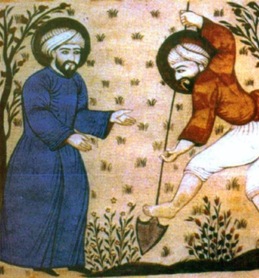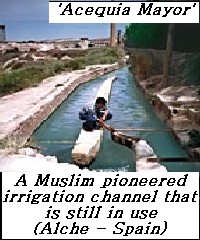By Salah Zaimeche
 History books in schools usually convey the notion that the agricultural revolution took place in recent times in the form of rotation of crops, advanced irrigation techniques, plant improvements, etc… some such changes only taking place in the last couple of centuries in Europe, and some even taking place nowadays.
History books in schools usually convey the notion that the agricultural revolution took place in recent times in the form of rotation of crops, advanced irrigation techniques, plant improvements, etc… some such changes only taking place in the last couple of centuries in Europe, and some even taking place nowadays.
It is explained that such revolutionary changes fed the increasing European population, released vast numbers from the land and allowed agriculture to produce a capital surplus, which was invested in industry, thus leading to the industrial revolution of the 18th-19th century.
This is the accepted wisdom until one comes across works on Muslim agriculture and discovers that such changes took place over ten centuries ago in the Muslim world, some such changes being the foundations of much of what we have today.
Watson, Glick and Bolens, in particular, indeed, show that the major breakthroughs were achieved by Muslim farmers on the land, and by Muslim scholars with their treatises on the subject.
Thus, as with other subjects, prejudice distorts history, Muslim achievements of ten centuries ago covered up; a point raised by the French scholar, Cherbonneau, who holds: ‘It is admitted with difficulty that a nation in majority of nomads could have had known any form of agricultural techniques other than sowing wheat and barley.
The misconceptions come from the rarity of works on the subject… If we took the bother to open up and consult the old manuscripts, so many views will be changed, so many prejudices will be destroyed.’
The Agricultural Revolution
As early as the ninth century, a modern agricultural system became central to economic life and organization in the Muslim land.
The great Islamic cities of the Near East, North Africa and Spain, Artz explains, were supported by an elaborate agricultural system that included extensive irrigation and an expert knowledge of the most advanced agricultural methods in the world.
The Muslims reared the finest horses and sheep and cultivated the best orchards and vegetable gardens. They knew how to fight insect pests, how to use fertilizers, and they were experts at grafting trees and crossing plants to produce new varieties.
Glick defines the Muslim agricultural revolution in the introduction of new crops, which, combined with extension and intensification of irrigation, created a complex and varied agricultural system, whereby a greater variety of soil types were put to efficient use; where fields that had been yielding one crop yearly at most prior to the Muslims were now capable of yielding three or more crops, in rotation; and where agricultural production responded to the demands of an increasingly sophisticated and cosmopolitan urban population by providing the towns with a variety of products unknown in Northern Europe.
Whilst for Scott, the agricultural system of the Spanish Muslims, in particular, was `the most complex, the most scientific, the most perfect, ever devised by the ingenuity of man.’
Such advancement of Muslim farming, according to Bolens, was owed to the adaptation of agrarian techniques to local needs, and to `a spectacular cultural union of scientific knowledge from the past and the present, from the Near East, the Maghreb, and Andalusia.
A culmination subtler than a simple accumulation of techniques, it has been an enduring ecological success, proven by the course of human history.’
Fertilizers, in their variety, were used according to a well-advanced methodology; whilst a maximum amount of moisture in the soil was preserved.
Soil rehabilitation was constantly cared for, and preserving the deep beds of cropped land from erosion was, according to Bolens, again, `the golden rule of ecology,’ and was `subject to laws of scrupulous careful ecology.’
For Scott, the success of Islamic farming also lay in hard enterprise. No natural obstacle was sufficiently formidable to check the enterprise and industry of the Muslim farmer. He tunneled through the mountains; his aqueducts went through deep ravines, and he leveled with infinite patience and labor the rocky slopes of the sierra (in Spain).
The rise of productivity of agricultural land and sometimes of agricultural labor owe to the introduction of higher yielding new crops and better varieties of old crops, through more specialized land use which often centered on the new crops, through more intensive rotations which the new crops allowed, through the concomitant extension and improvement of irrigation, through the spread of cultivation into new or abandoned areas, and through the development of more labor intensive techniques of farming.
These changes, themselves, were positively affected by changes in other sectors of the economy: growth of trade, enlargement of the money economy, increasing specialization of factors of production in all sectors, and with the growth of population and its increasing urbanization.
Irrigation, from Andalusia to the far East, from the Sudan to Afghanistan, remained central, `the basis of all agriculture and the source of all life.’
The ancient systems of irrigation the Muslims became heirs to were in an advanced state of decay, and ruins.’
The Muslims repaired them and constructed new ones; besides devising new techniques to catch, channel, store and lift the water, and making ingenious combinations of available devices.
All of the Kitab al-Filahat (book of agriculture), whether Maghribi, Andalusian; Egyptian, Iraqi; Persian or Yemenite, Bolens points out, insist meticulously on the deployment of equipment and on the control of water.
Water Management
 Water, so precious a commodity in a more Islamically aware age, was managed according to stringent rules, any waste of the resource banned, and the most severe economy enforced. Thus, in the Algerian Sahara various water management techniques were used to make the most effective use of the resource.
Water, so precious a commodity in a more Islamically aware age, was managed according to stringent rules, any waste of the resource banned, and the most severe economy enforced. Thus, in the Algerian Sahara various water management techniques were used to make the most effective use of the resource.
The Foggaras, a network of underground galleries, conducted water from one place to the other over very long distances so as to avoid evaporation. Although the system is still in use today, the tendency at present is for over-use and waste of water. Still in Algeria, in the Beni Abbes region, in the Sahara, south of Oran, farmers used a clepsydra to determine the duration of water use for every user in the area.
This clepsydra regulates with precision, and night and day, the amount going to each farmer, timed by the minute, throughout the year, and taking into account seasonal variations. Each farmer is informed of the timing of his turn, and summoned to undertake necessary action to ensure effective supply to his plot.
In Spain, the same strict management was in operation. The water conducted from one canal to the other was used more than once, the quantity supplied accurately graduated; distributing outlets were adapted to each soil variety, two hundred and twenty four of these, each with a specific name.
All disputes and violations of laws on water were dealt with by a court-whose judges were chosen by the farmers themselves, this court named The Tribunal of the Waters, which sat on Thursdays at the door of the principal mosque. Ten centuries later, the same tribunal still sits in Valencia, but at the door of the cathedral.
The Loss of Ecological Balance
`With a deep love for nature, and a relaxed way of life, classical Islamic society,’ Bolens concludes, `achieved ecological balance, a successful average economy of operation, based not on theory but on the acquired knowledge of many civilized traditions.’
It was colonialism, she recognizes, which subsequently and seriously upset the traditional agricultural balance in order to increase profitability for the colonizers.
The decline of agriculture as the destruction of other aspects of Islamic civilization had, however, begun with the various invaders, from the Crusaders to the Mongols, from the Banu Hillal to the Normans and Spain’s conquistadors in the West. Such invasions caused the ruin of irrigation works, destroyed permanent crops, closed down trade routes, and caused farmers to take flight.
The Muslim farmers also became over taxed by their new masters in Christian Spain and Sicily, and were exterminated in those countries; their system perishing with them.
The later colonizers, the French, only finished off whatever was left. No better place to see that than in Algeria, where the French on arrival in 1830 found a much greener country than the one they left 130 years later, and a population living more or less in harmony with its environment. In their wars of devastation against Algerian resistance, the French destroyed the garden rings that surrounded towns and cities, cutting trees and orchards.
After that, they deforested whole regions to exploit timber, and took all fertile lands from their Muslim owners, forcing them to subside on arid lands, and in the vicinity of forests causing their degradation.
Later, during the war of independence 1954-62, the French set ablaze millions of acres of forest lands; and then departed, leaving a legacy of bareness and hostility to greenery from which the Algerians have not recovered yet.
—————————–
Courtesy www.muslimheritage.com with slight editorial modifications to the original article titled: Muslims’ Contribution to Agriculture.
FSTC stands for the Foundation for Science Technology and Civilization. The Foundation for Science, Technology and Civilisation (FSTC) is a British not-for-profit, non-political, and non-religious organisation founded in 1999 by a group of philanthropic historians, scientists, engineers and social scientists. It is dedicated to researching and popularising the history of pre-Renaissance civilisations, especially the Muslim civilisation, that have had an impact upon the scientific, technological and cultural heritage of our modern world.
 Arabic
Arabic English
English Spanish
Spanish Russian
Russian Romanian
Romanian korean
korean Japanese
Japanese
